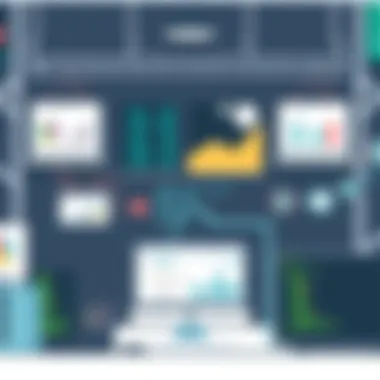A Comprehensive Look at Electrical Estimating Software


Intro
Electrical estimating software has become a cornerstone tool for professionals within the electrical contracting industry. As projects grow in complexity and the demand for accuracy increases, the need for reliable software solutions has never been greater. In this article, we delve into a detailed evaluation of premier electrical estimating software, aiming to provide insights that resonate with both seasoned veterans and those new to the field.
The software landscape is vast, offering a multitude of options that cater to different user needs. From small electrical firms to large organizations, each has unique requirements that must be addressed. Thus, selecting the right estimating software involves a careful consideration of various factors, including features, integration capabilities, and overall usability.
By emphasizing key features and discussing user experiences, we hope to offer a comprehensive look into what today's electrical estimating software has to offer. As we proceed, we will also touch on technical specifications, which play a critical role in making informed decisions.
The goal is straightforward: to equip you with the knowledge necessary for navigating the software options in a way that aligns with your specific needs. In doing so, we aim to help elevate not only the efficiency of your estimating processes but also the quality of your overall business operations.
With this frame of reference, let’s jump right into the software overview.
Understanding Electrical Estimating Software
When it comes to managing electrical projects, one can’t overlook the role of electrical estimating software. This tool is not just a luxury for companies but rather a necessity in today’s fast-paced environment. Understanding this software deeply can uncover its strong influence on project outcomes and, ultimately, the bottom line.
Defining Electrical Estimating Software
At its core, electrical estimating software is designed to help professionals calculate the costs associated with electrical projects. The software can range from basic applications that do simple cost calculations to comprehensive programs that factor in labor, materials, overhead, and profit margins.
In many cases, electrical estimating software includes modules that address various components of electrical work. For instance, it can help estimate costs for wiring, circuit breakers, and switches. Also, such software often supports the inclusion of different units of measurement, enabling estimators to work with both metric and imperial systems easily.
It’s important to choose software that not only fits the current needs but also offers scalability. As electrical projects vary, flexibility in the software can accommodate diverse scenarios, mitigating the risk of under or overestimating.
Importance of Accurate Estimations in the Electrical Sector
Accurate estimations hold monumental importance in the electrical sector. One might say, "A penny saved is a penny earned," and that rings true here. By ensuring precision in estimations, companies can manage resources efficiently, reduce waste, and secure profitable contracts.
"Inaccurate estimates can lead to overspending, missed deadlines, and lost contracts."
The implications of sloppy estimations stretch far beyond immediate financial losses. An inaccurate estimate can damage client relationships, create reputational risk, and lead to project delays. In essence, estimators are the beacon guiding the project from conception through completion. Their calculations feed into budgets, timelines, and scopes, making their roles crucial for the success of any electrical contracting operation.
Some benefits of accurate estimations include:
- Improved Profit Margins: Ensuring that all costs are accounted for leads to good profit margins.
- Client Trust: Transparent, accurate estimates help build strong relationships with clients.
- Resource Management: Helps in optimizing the workflow and resource allocation for projects.
Thus, diving into electrical estimating software is not merely a technical endeavor; it's about leveraging a tool that can fundamentally alter how a business operates in a competitive landscape. Investing in the right software aids in making precise calculations, ultimately steering the organization toward success.
Key Features to Consider
When selecting electrical estimating software, focusing on key features is paramount for making an informed decision. These attributes can drastically affect not only the ease of use but also the overall effectiveness of the software in fulfilling one's estimating needs. The right software should streamline processes, reduce human error, and bolster productivity.
User Interface and Experience
A clean and intuitive user interface can elevate the work experience, allowing users to navigate without barriers. Imagine an estimator who's pressed for time, needing to whip up a quick quote. If the software’s interface is cluttered or unintuitive, it can just lead to frustration. Easy-to-read dashboards and logically organized tools save clicks and keep workflow smooth. Investing time in choosing software with a user-friendly design can impact the efficiency of the entire estimating process. This means less time training staff and more hours dedicated to actual project work.
Integration with Other Tools
In the modern workspace, the software doesn’t exist in a vacuum. Integration with other tools is a must-have feature. Popular software like AutoCAD or project management suites should easily sync with your estimating solution. Think about how separate systems can lead to duplicative data entry or miscommunication among teams. A software that allows smooth integration ensures all departments stay on the same page, reducing the chances of costly errors down the line.


Estimating Accuracy and Speed
Accuracy and speed are the two sides of the same coin when it comes to estimations. If a software can crank out estimates quickly but sacrifices precision, it's hardly worth the investment. Consider how using advanced algorithms and databases can enable precise calculations while speeding up the process. You will want software that not only covers all angles but also learns over time from completed projects to enhance future estimates. A solution that boosts both speed and accuracy can substantially improve bid competitiveness.
Reporting Capabilities
Well-designed reporting tools can make all the difference in decision-making. A robust reporting feature allows businesses to analyze past projects, understand profitability, and identify areas of risk. Users should be able to generate customizable reports that highlight key performance indicators. Remember, detailed reports can help stakeholders make strategic decisions. In many ways, the insights gleaned from these reports can be as valuable as the estimates themselves.
Customization Options
Customization is another feature to keep at the forefront of your mind when evaluating software. Every electrical contracting business has unique workflows and requirements. Software that allows for flexibility, whether it comes to templates, calculations, or integrations, can drastically improve usability. Tailoring the functions to fit specific needs means using the software to its highest potential. It’s essential to think about whether the solution can grow as your business evolves; after all, what works today may not tomorrow.
A software’s adaptability is a reflection of its quality; the more it fits your needs, the more effective it will be.
Making an informed choice about electrical estimating software is akin to laying a solid foundation for a building. Without the right features, even the best solutions may crumble under pressure. Keep these key considerations in mind, and you'll set yourself on the path toward repeated success.
Top Electrical Estimating Software Solutions
In the rapidly evolving landscape of the electrical contracting sector, selecting the right estimating software can become a game changer. This segment serves a dual purpose: it not only enumerates the prominent Software Solutions available but also highlights the unique features that differentiate each tool. By analyzing these software options, professionals can better align their specific needs with the capabilities of the software, making informed choices that can enhance precision, efficiency, and ultimately profitability.
Software A: Overview and Features
Software A is known for its intuitive interface and robust functionality. It blends user-friendly design with powerful features suitable for both small firms and larger enterprises.
- Key Features:
- Real-time Collaboration: Teams can work simultaneously, reducing bottlenecks in the estimation process.
- Advanced Reporting Tools: Provides customizable reports that aid in performance evaluation and strategic planning.
- Mobile Compatibility: Accessible on various devices, facilitating fieldwork and client communication.
This software also integrates seamlessly with popular tools such as QuickBooks, increasing its utility in financial management. By leveraging those features, users can significantly reduce estimating time while enhancing accuracy.
Software B: Overview and Features
Software B stands out with its emphasis on accuracy and scalability. It prides itself on being particularly effective for contractors handling large-scale projects. Its architecture supports thousands of items in its database, making it suitable for detailed and expansive estimates.
- Key Features:
- Cloud-based Platform: Ensures that users can access their data anytime, anywhere, which is vital for projects spread across locations.
- Dynamic Pricing Updates: Automatically adjusts labor and material costs based on market fluctuations, aiding in maintaining competitive bids.
- Integrated Project Management: Streamlines project tracking and resource planning alongside estimation tasks.
Such functionality allows users to navigate intricate project requirements without missing a step, thus making it an appealing choice for contractors aiming for comprehensive project oversight.
Software C: Overview and Features
Software C positions itself as a budget-friendly option without skimping on essential features. It caters particularly well to freelancers and small contractors who might find high-cost solutions restrictive.
- Key Features:
- Template Estimating: Offers a library of templates that can simplify the estimation process for common tasks and materials.
- Intuitive Tutorial: Facilitates swift onboarding for new users, ensuring they can hit the ground running.
- Offline Access: Users can continue to work without an internet connection, a boon in remote areas.
Despite its lower price point, many users find that Software C packs sufficient complexity and adaptability for various project sizes and requirements.
Software D: Overview and Features


Finally, Software D combines cutting-edge technology with a focus on environmental sustainability. It is tailored for those who aim to incorporate green building practices into their contracting work.
- Key Features:
- Sustainability Metrics: Includes tools to assess energy consumption and recommend environmentally friendly materials, useful in today’s eco-conscious landscape.
- Visualization Tools: Allows users to create visual representations of their estimates, improving clarity for clients and stakeholders alike.
- Comprehensive API Access: Enables users to customize and enhance functionalities according to their unique operational needs.
This software garners attention in a market increasingly driven by sustainability, appealing to contractors looking to differentiate themselves through responsible practices.
"Choosing the right estimating software isn't just a decision; it's a strategy for growth and efficiency in a competitive field."
By considering these top software solutions, professionals in the electrical sector can evaluate their options against their specific requirements, ensuring they choose a tool that not only facilitates their current needs but also prepares them for future growth.
Assessing Value for Money
When it comes to choosing electrical estimating software, assessing value for money is a pivotal consideration that can determine the success of a business's operations. In today’s competitive market, professionals must weigh not just the upfront costs but also the long-term benefits and capabilities that software brings to the table. The aim is to make a choice that optimizes both budget and functionality.
Software that appears affordable may sometimes end up being costly when hidden fees, lack of essential features, or poor user experience come into play. Conversely, a higher-priced option might deliver features that can significantly accelerate workflow and increase profitability. Therefore, a comprehensive understanding of price structures, along with a clear grasp of what each software solution offers, becomes essential.
Pricing Models and Subscription Plans
Most electrical estimating software uses a variety of pricing models to cater to different business needs. Here's a breakdown of the common options:
- One-time purchase: This traditional model allows users to pay a single fee for lifetime access to the software. While it may seem inviting, updates and support typically aren’t guaranteed post-purchase.
- Subscription-based: This plan requires users to pay a recurring fee, usually monthly or annually. The upside is ongoing updates and support, which can be a significant help in keeping up with industry standards.
- Tiered pricing: Some software solutions offer different levels of service at varying prices. This model enables businesses to choose a plan that matches their size and needs, facilitating scalability.
- Freemium model: A no-cost version with limited features can serve as a gateway for users. This model allows potential customers to test the software before committing financially.
Understanding these pricing models allows a business to align its budgeting strategy with its operational needs. Be sure to assess how upgrades or additional features may impact overall costs down the road.
Cost vs. Feature Analysis
Now that we have a grasp on the pricing, it’s crucial to analyze the cost versus the features offered by different software solutions. This comparison can uncover the true value a software solution brings:
- Essential Features: Ensure the software has fundamental capabilities like accurate estimations, reporting, and integration options that meet your core requirements.
- Advanced Features: Explore whether features such as mobile accessibility, cloud storage, and advanced analytics justify higher costs.
- User Experience: A more intuitive design can save time and training costs, making it worthwhile to explore software that may initially seem pricier.
- Hidden Costs: Some software might lure you in with great pricing but may have add-ons or charges for updates and customer support that accumulate over time.
An exhaustive feature analysis in juxtaposition with the cost will serve as a detailed matrix to help in discerning which software delivers not just a fair price, but true value for money.
"Price is what you pay; value is what you get." - Warren Buffett
The Role of User Feedback
When choosing electrical estimating software, the voice of the user is a powerful tool. User feedback provides valuable insights about software performance, user experience, and potential shortfalls that aren't immediately apparent in marketing materials. Understanding the role of user feedback can elevate the decision-making process, making it more reliable and occurring smoothly.
The importance of user feedback in this context can’t be overstated. Users often share their real-world experiences, offering unfiltered insights about how the software operates in everyday scenarios. This is essential for IT professionals and businesses who need to feel confident that the tools they choose will meet their operational needs and expectations.
"User feedback is like having a compass in the wilderness; it helps navigate the densely populated choices of software."
Evaluating Peer Reviews and Testimonials
Peer reviews and testimonials are crucial elements when evaluating estimating software. These reviews can serve as a litmus test of sorts, revealing what actual users think about the software’s utility and reliability. A mix of positive and negative feedback is valuable; it gives a complete picture rather than a glossed-over version filled with only high praise.
Some factors to consider during this evaluation include:
- Documentation of Use Cases: Users often share detailed accounts of how they applied the software in specific projects. This can help others foresee possible issues or advantages they hadn't considered.
- Comparison with Alternatives: Reviews often mention how a particular software stacks up against competitors. This can guide decisions about whether it’s worth investing in a specific solution or considering others.
- Response Time to Issues: Many users note how quickly the support team addresses concerns. A responsive support system can make a world of difference when emergencies arise.


With platforms like Reddit or specialized forums dedicated to electrical contracting, peers can discuss, rate, and outline their user experience, contributing to an authentic assessment of features and overall satisfaction.
Impact on Decision Making
User feedback directly impacts decision-making processes in several ways. First, it shapes perceptions of efficiency and functionality. If multiple users share similar issues with a particular software, it becomes evident that prospective users should either proceed with caution or look elsewhere.
Moreover, those considering acquiring a specific solution can use user feedback to set realistic expectations. If software promises quick estimations but reviews highlight slow processing times, future users can be prepared for what they might encounter.
In addition, feedback can also help identify the following:
- Suitability for Specific Industries: Some software may be tailored for commercial electrical work, while others might cater better to residential projects. Knowing this can help target the right software for different needs.
- Cost-Effectiveness: Through user insights, potential buyers can gauge whether the features of the software justify its price. This aspect is often crucial when balancing budgets against project demands.
Ultimately, decisions informed by user feedback can yield smoother transitions into new software, helping avoid hurdles and maximizing the chances for successful implementation.
Implementation Challenges
When diving into the realm of electrical estimating software, it's nearly impossible to sidestep the stark realities of implementation challenges. These challenges can make or break the success of a new system within an organization. Beyond just acquiring software, it’s about making sure that it fits seamlessly into the existing workflow and enhances efficiency rather than disrupts it. Understanding these elements is crucial for achieving a smooth transition and fully realizing the benefits of the software.
Training and Onboarding Needs
When new software comes into play, the first hurdle is often the training and onboarding process. Even the most sophisticated software won't deliver its full potential if the users aren't equipped with the know-how to navigate it. Providing clear training pathways not only helps users become proficient but also fosters confidence in utilizing the tools at their disposal. It’s essential to consider:
- Customized Training Sessions: Every team has different strengths and weaknesses; tailored training can address specific needs.
- Hands-On Workshops: Real-time learning in a practical context helps solidify understanding.
- Resource Availability: Ongoing access to training manuals, user videos, or even online forums can make a world of difference, keeping learning ongoing and allowing users to refresh their knowledge whenever they feel the need.
Also, specific metrics can be vital. Establishing benchmarks before implementing the software can help track progress and improvements post-training. Many organizations find success in using KPI’s (Key Performance Indicators) to monitor how well the training is working. For instance, if error rates in estimates drop significantly after training completion, it’s a good sign that users are on the right track.
Transitioning from Traditional Methods
Shifting from the old ways of estimating to modern electrical estimating software involves a steep learning curve, one that can be fraught with resistance from the workforce. Transitioning from traditional methods—like manual calculations and spreadsheets—can stir apprehension, especially among seasoned professionals who may be entrenched in their ways. This challenge demands a thoughtful approach.
- Communication is Key: Clear communication about why the change is necessary can help mitigate fears. Demonstrating the efficiencies, accuracies, and results can shift perceptions.
- Small Steps Matter: Gradual implementation often yields better acceptance. Start with less complex projects, allowing users to build their confidence before tackling larger tasks.
- Feedback Loops: Encourage users to provide feedback during and after the transition. Understanding their concerns can help identify and address pain points, making the process smoother for everyone involved.
"Implementation isn’t just about technology; it’s about the people who will ultimately use it. Their buy-in is crucial to success."
By acknowledging these barriers, companies can create a robust framework that tackles the inherent difficulties of adopting new technology. Investment in comprehensive training and a thoughtful transition process can yield impressive returns on investment and set the stage for long-term success.
Future Trends in Electrical Estimating Software
As we peer into the horizon of electrical estimating software, it is evident that the landscape is shifting under the influence of technology and market needs. Understanding these future trends is crucial for both prospective purchasers and current users of these tools. This section aims to unpack these trends and their implications, demonstrating how they serve as the backbone of progress within the electrical estimating realm.
Emerging Technologies and Their Impact
The advent of technologies like artificial intelligence and machine learning is reshaping how electrical estimating software operates. Automation has taken a hold, simplifying the often laborious process of calculations and enabling users to minimize manual input. Imagine a system where predictive algorithms assess historical data patterns, refining estimations with an accuracy that can only be described as remarkable.
- AI Integration: Modern systems are increasingly embedding AI, which helps in generating quicker estimates by analyzing vast databases of materials and labor costs from previous projects. This not only speeds up the estimating process but also helps in reducing human errors. Some software can even predict potential overruns based on similar past projects.
- Cloud Computing: Cloud technology is another crucial aspect, allowing teams to collaborate in real-time no matter their location. The days of waiting for a single person to finalize a document are fading. Everyone can have input—easing the workflows and streamlining communication.
"The future is not about technology itself, but how we harness it to serve our goals effectively."
With these innovations, the focus shifts from traditional methods to a more integrated approach that caters to practical, everyday needs. The utilization of new tech rejuvenates outdated processes, paving the way for smarter solutions that enhance productivity in the electrical construction industry.
Sustainability Considerations
In today’s environmentally conscious landscape, sustainability isn’t just a buzzword—it's becoming a fundamental expectation in how businesses operate, including the field of electrical estimating. The development of software that prioritizes ecological factors is gaining traction, altering the ways estimators approach projects.
- Energy Efficiency: Electrical estimating software can now provide guidance on energy-efficient materials and systems, promoting options that not only meet client needs but also align with sustainable practices.
- Waste Minimization: Advanced programs allow estimators to pinpoint resource usage, suggesting optimal quantities and reducing excess materials. This approach helps in minimizing waste, cutting costs, and making a notable environmental impact.
- Regulatory Compliance: As regulations regarding energy efficiencies intensify, the best software solutions will proactively incorporate these standards. Users can trust that their estimates meet both local and national sustainability expectations.
By aligning themselves with sustainability goals, electrical estimating professionals not only contribute to the preservation of resources but also strengthen their market positioning. This trend emphasizes a growing understanding in the industry: adopting responsible practices gives an edge both in public perception and operational success.







